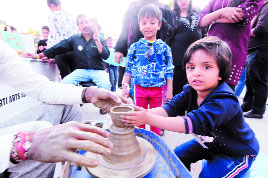Indian board games present themselves as a far better pastime for children than ‘advanced’ toys. The former is mentally stimulating and nourishing.
Indian games have become almost extinct since social media and video games have taken over the attention spans of children. Board games like Snakes and Ladders, strategy games like Chess or even card games like Patience that helped develop a child’s brain by testing memory and cognitive skills have become a novelty.
There are several reasons why the board games are making a comeback as opposed to the ones played on a screen. These are believed to be beneficial for the brain. They stimulate the hippocampus and prefrontal cortex, which are responsible for complex thought and memory formation. Board games help the brain retain and build cognitive associations well into old age too. It has been known for preventing cognitive decline, which is associated with dementia and Alzheimer’s.
A good place to pick them up is an exhibition called Jack & Jill, the wonder years festival which has multiple stalls and activities for the little ones. While there is the usual clutter of clothes and the usual toys, there were four stalls that stood apart amidst the din at the the National Railway Museum where the exhibition is being held. There were of course the usual families, school children and hassled teachers who stood and sat around waiting for their chance to get on the toy trains that take you around the venue for a joy ride. Huge trains and little children waited patiently side by side for the driver to start the ride. Even while the main attraction of the museum are obviously the train models stationed everywhere but there were other treasures to be found too.
At Nazariya a design studio one couldn’t help but notice several unique items. A coir tree created by artist Harikrishna Parida from Chandpur, Odisha, diaries with Gond and Patachitra art from Madhya Pradesh and West Bengal respectively. There were the mandatory jewellery and diaries made by masters of handicrafts across India. But what caught our eye were games like the Aadu Puli Attam which in Tamil means The Lambs and Tigers.
A strategic, two-player (or two team) leopard hunt game that is played in South India, it is meant for children above eight. One player controls three tigers and the other player up to 15 lambs/goats. The tigers ‘hunt’ the goats while the goats attempt to block the tigers’ movements. The chequered lines across the red and yellow cloth board and the stone pieces made for an interesting way to spend an evening.
Another game called the Pallankuzhi, which apparently Sita used to play, reminded one of an African tribal game called the Mancala. The wooden board with bowls and tiny glass pebbles does not end until one player has no pebbles to continue with. The start-up also brought with them the miniature version of the Chaupad called Ashtachema and there were also small diaries decorated with Kalighat paintings and miniature Phads from Rajasthan. The studio also brought with them rare art forms like the Kaavi, from the Konkan coast which only exists in two temples in Goa currently and Bidri art from Karnataka which is made in the village of Bidar.
But not just old Indian games, more contemporary ones but indigenously developed too could be seen here. Sphero’s stall was dotted with robots that stood about 15 cm tall. But don’t go on their diminutive size, for they can teach coding and programming.
The pottery and science stalls — each appealing to different faculties of the brain — Murti Arts Academy and Wonderlab, held small workshops because they believe that the only way to teach children and engage them is by showing them how it is done. Children observe and absorb before they get engaged in a creative pursuit.
Multiple children of all sizes, some pulling their pants up during a small dance workshop with a choreographer while proud parents milled around taking pictures could also be seen.
“A great event for the kids, a unique one that lets them enjoy and learn at the same time, as the children today have forgotten what outdoor fun is, the expo will inspire them to have fun and learn away from technology and gadgets,” said Ashwani Lohani, chairman and MD Railway Board.
Writer: Asmita Sarkar
Courtesy: The Pioneer








 OpinionExpress.In
OpinionExpress.In















Comments (0)